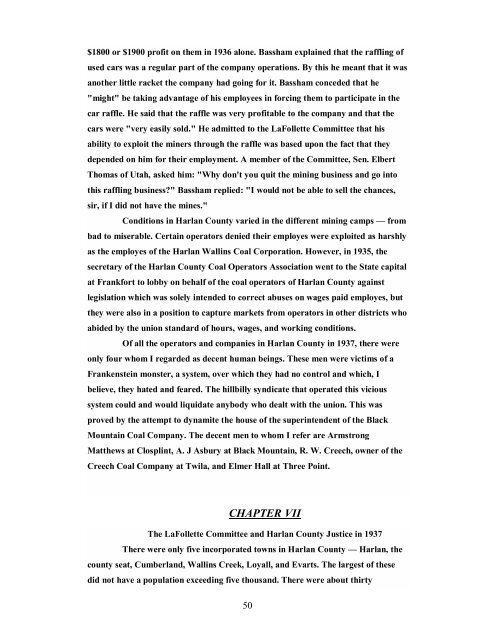Hell in Harlan - front page
Hell in Harlan - front page
Hell in Harlan - front page
Create successful ePaper yourself
Turn your PDF publications into a flip-book with our unique Google optimized e-Paper software.
$1800 or $1900 profit on them <strong>in</strong> 1936 alone. Bassham expla<strong>in</strong>ed that the raffl<strong>in</strong>g ofused cars was a regular part of the company operations. By this he meant that it wasanother little racket the company had go<strong>in</strong>g for it. Bassham conceded that he"might" be tak<strong>in</strong>g advantage of his employees <strong>in</strong> forc<strong>in</strong>g them to participate <strong>in</strong> thecar raffle. He said that the raffle was very profitable to the company and that thecars were "very easily sold." He admitted to the LaFollette Committee that hisability to exploit the m<strong>in</strong>ers through the raffle was based upon the fact that theydepended on him for their employment. A member of the Committee, Sen. ElbertThomas of Utah, asked him: "Why don't you quit the m<strong>in</strong><strong>in</strong>g bus<strong>in</strong>ess and go <strong>in</strong>tothis raffl<strong>in</strong>g bus<strong>in</strong>ess?" Bassham replied: "I would not be able to sell the chances,sir, if I did not have the m<strong>in</strong>es."Conditions <strong>in</strong> <strong>Harlan</strong> County varied <strong>in</strong> the different m<strong>in</strong><strong>in</strong>g camps — frombad to miserable. Certa<strong>in</strong> operators denied their employes were exploited as harshlyas the employes of the <strong>Harlan</strong> Wall<strong>in</strong>s Coal Corporation. However, <strong>in</strong> 1935, thesecretary of the <strong>Harlan</strong> County Coal Operators Association went to the State capitalat Frankfort to lobby on behalf of the coal operators of <strong>Harlan</strong> County aga<strong>in</strong>stlegislation which was solely <strong>in</strong>tended to correct abuses on wages paid employes, butthey were also <strong>in</strong> a position to capture markets from operators <strong>in</strong> other districts whoabided by the union standard of hours, wages, and work<strong>in</strong>g conditions.Of all the operators and companies <strong>in</strong> <strong>Harlan</strong> County <strong>in</strong> 1937, there wereonly four whom I regarded as decent human be<strong>in</strong>gs. These men were victims of aFrankenste<strong>in</strong> monster, a system, over which they had no control and which, Ibelieve, they hated and feared. The hillbilly syndicate that operated this vicioussystem could and would liquidate anybody who dealt with the union. This wasproved by the attempt to dynamite the house of the super<strong>in</strong>tendent of the BlackMounta<strong>in</strong> Coal Company. The decent men to whom I refer are ArmstrongMatthews at Clospl<strong>in</strong>t, A. J Asbury at Black Mounta<strong>in</strong>, R. W. Creech, owner of theCreech Coal Company at Twila, and Elmer Hall at Three Po<strong>in</strong>t.CHAPTER VIIThe LaFollette Committee and <strong>Harlan</strong> County Justice <strong>in</strong> 1937There were only five <strong>in</strong>corporated towns <strong>in</strong> <strong>Harlan</strong> County — <strong>Harlan</strong>, thecounty seat, Cumberland, Wall<strong>in</strong>s Creek, Loyall, and Evarts. The largest of thesedid not have a population exceed<strong>in</strong>g five thousand. There were about thirty50


